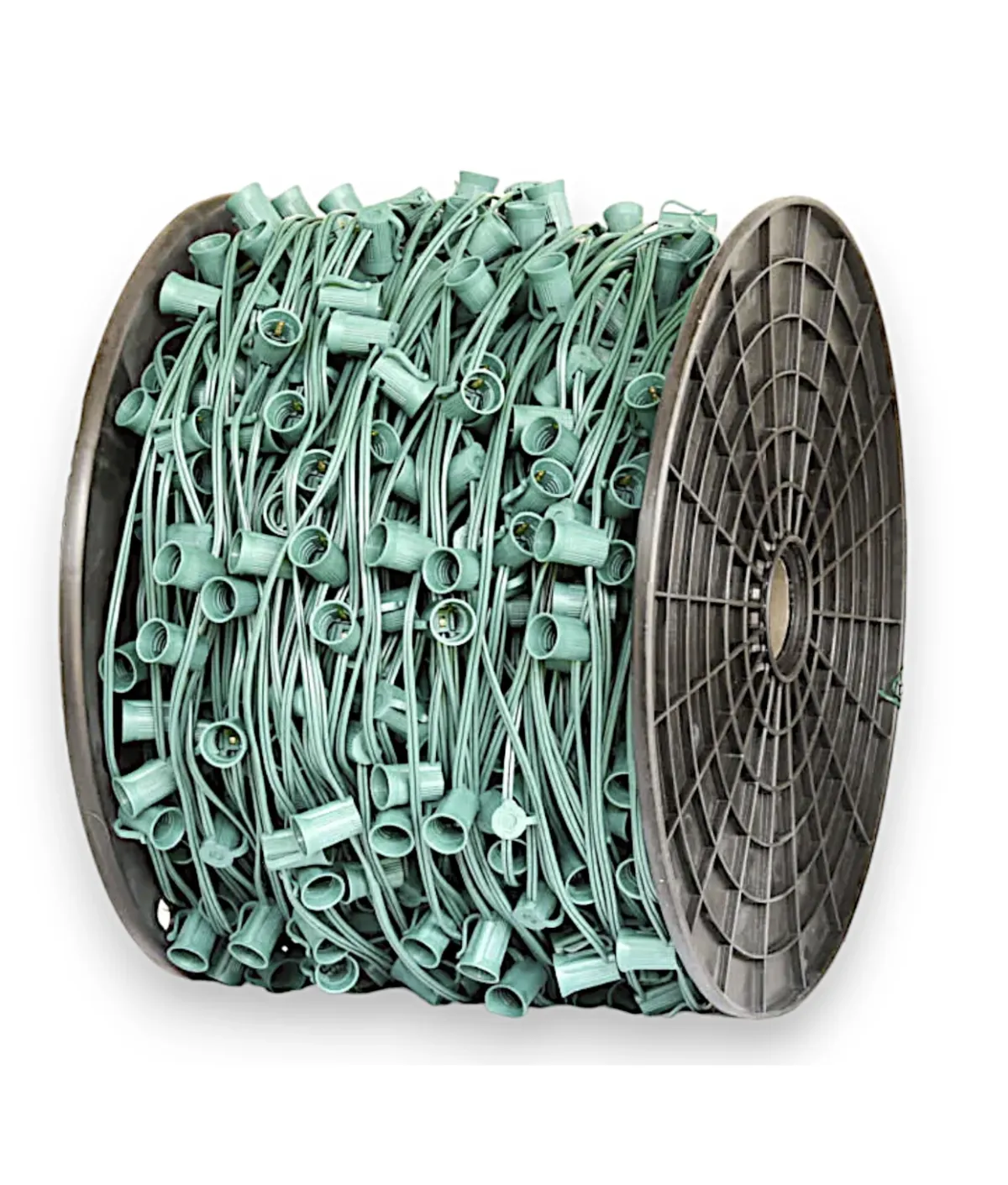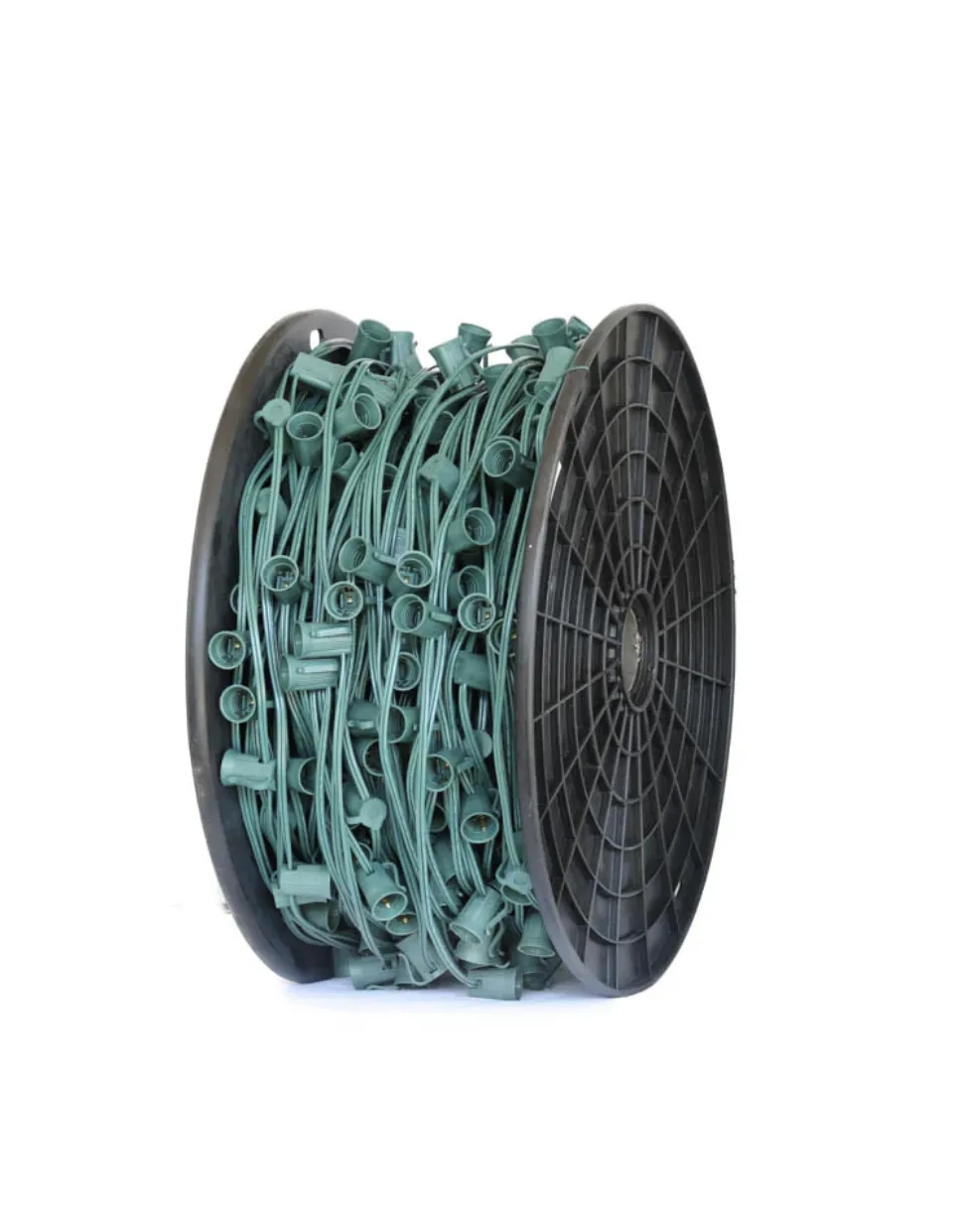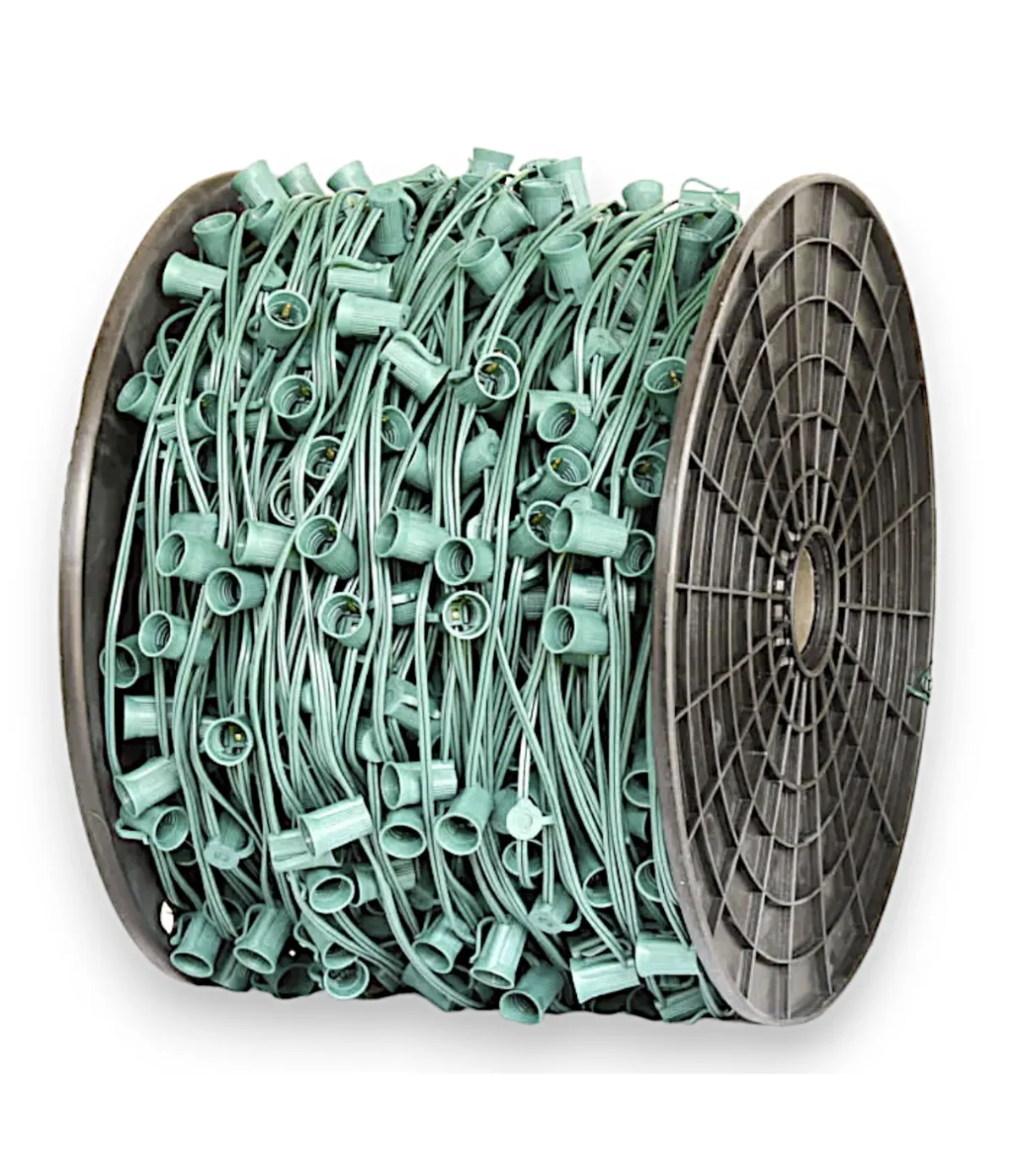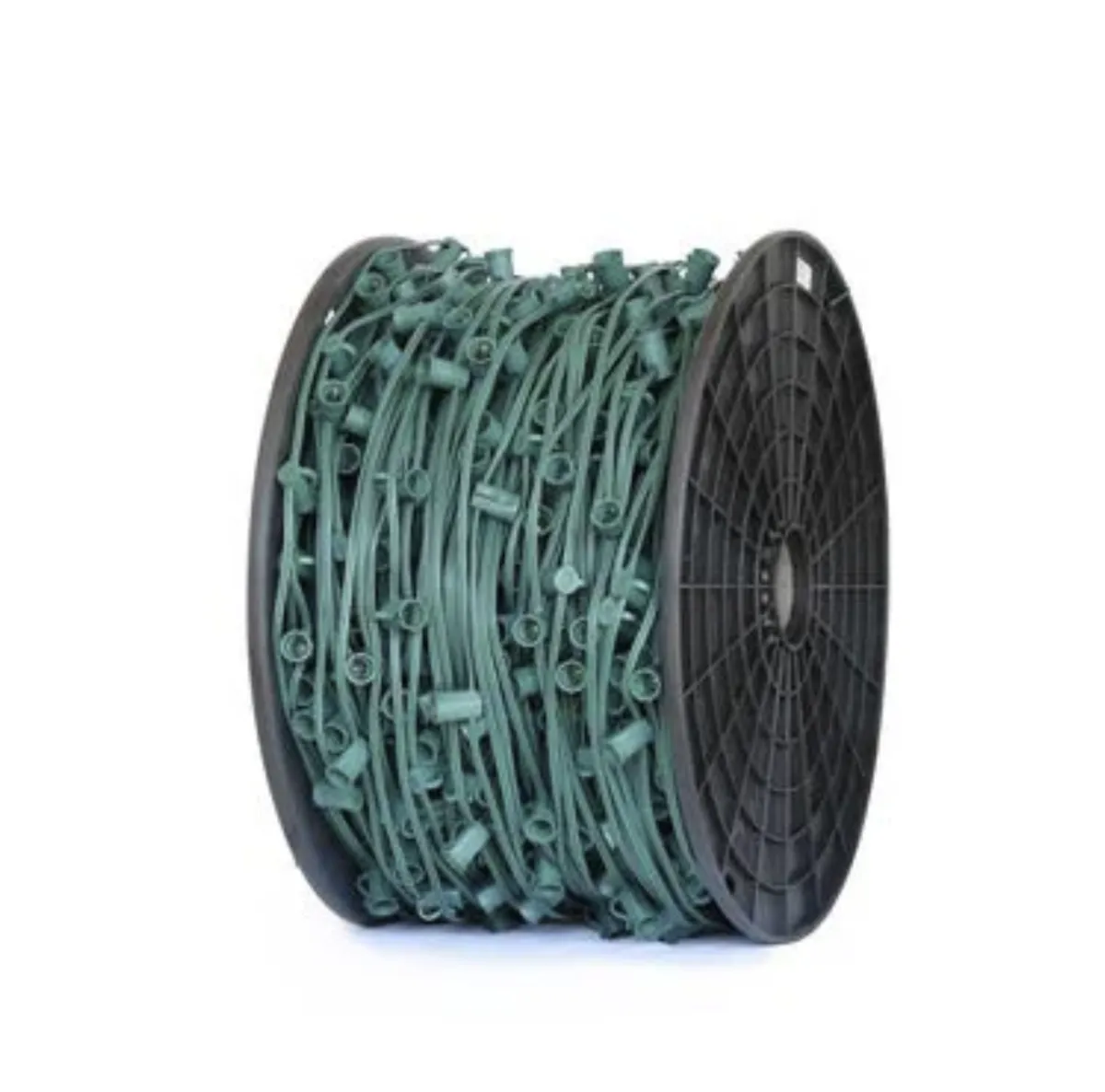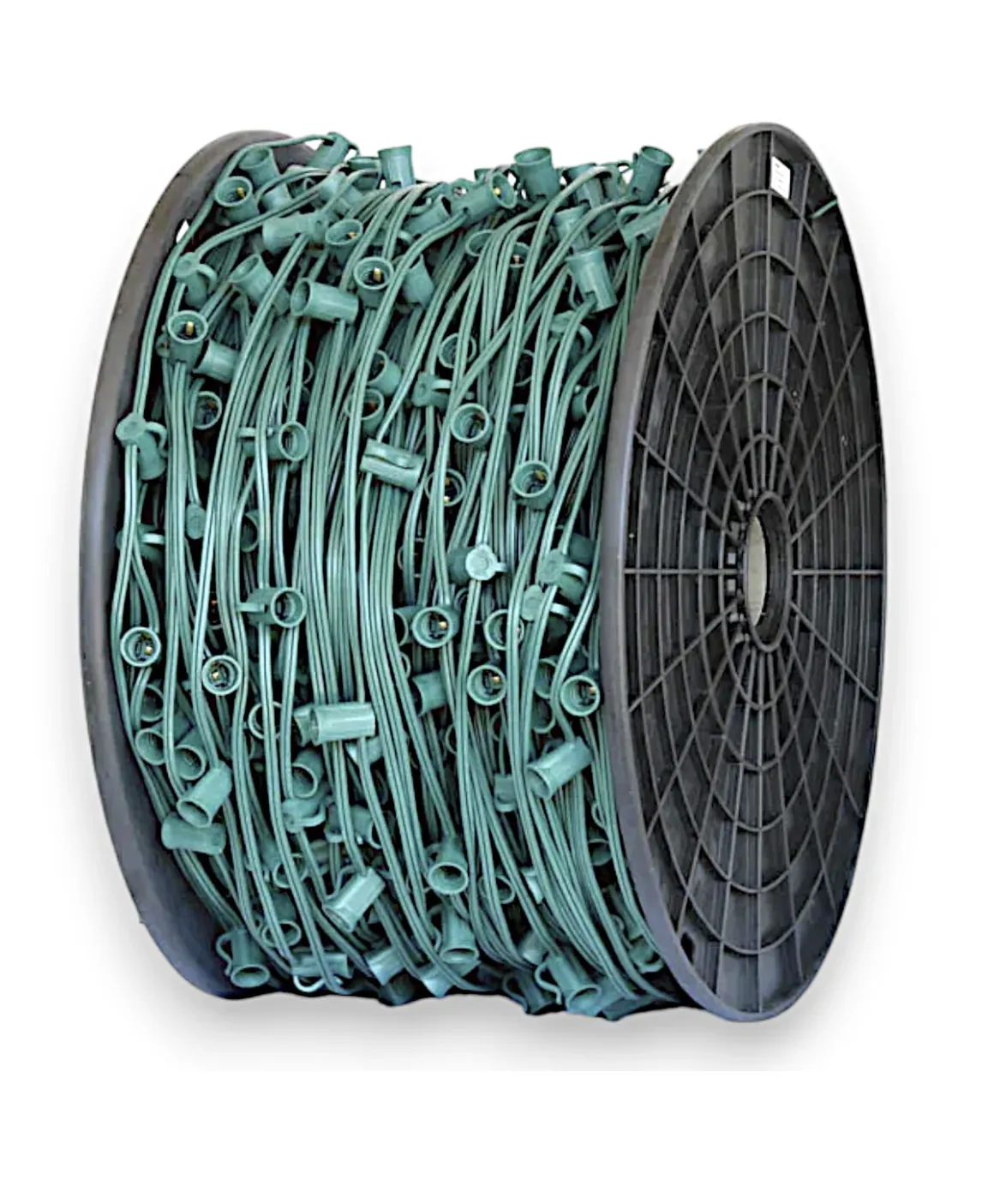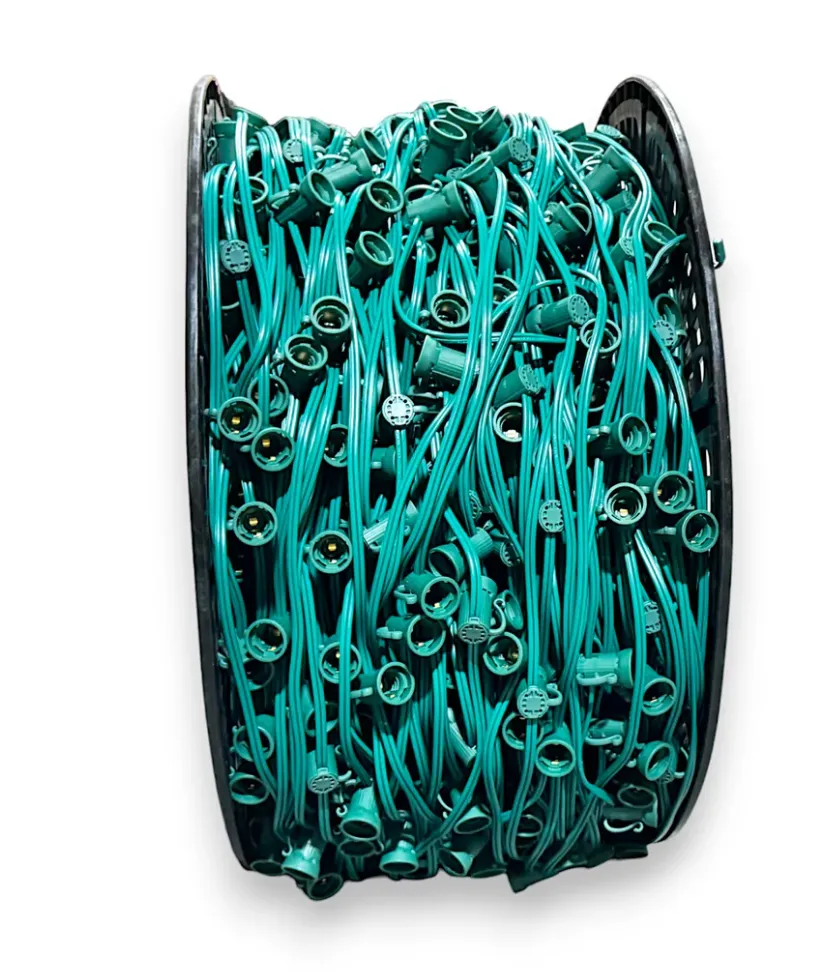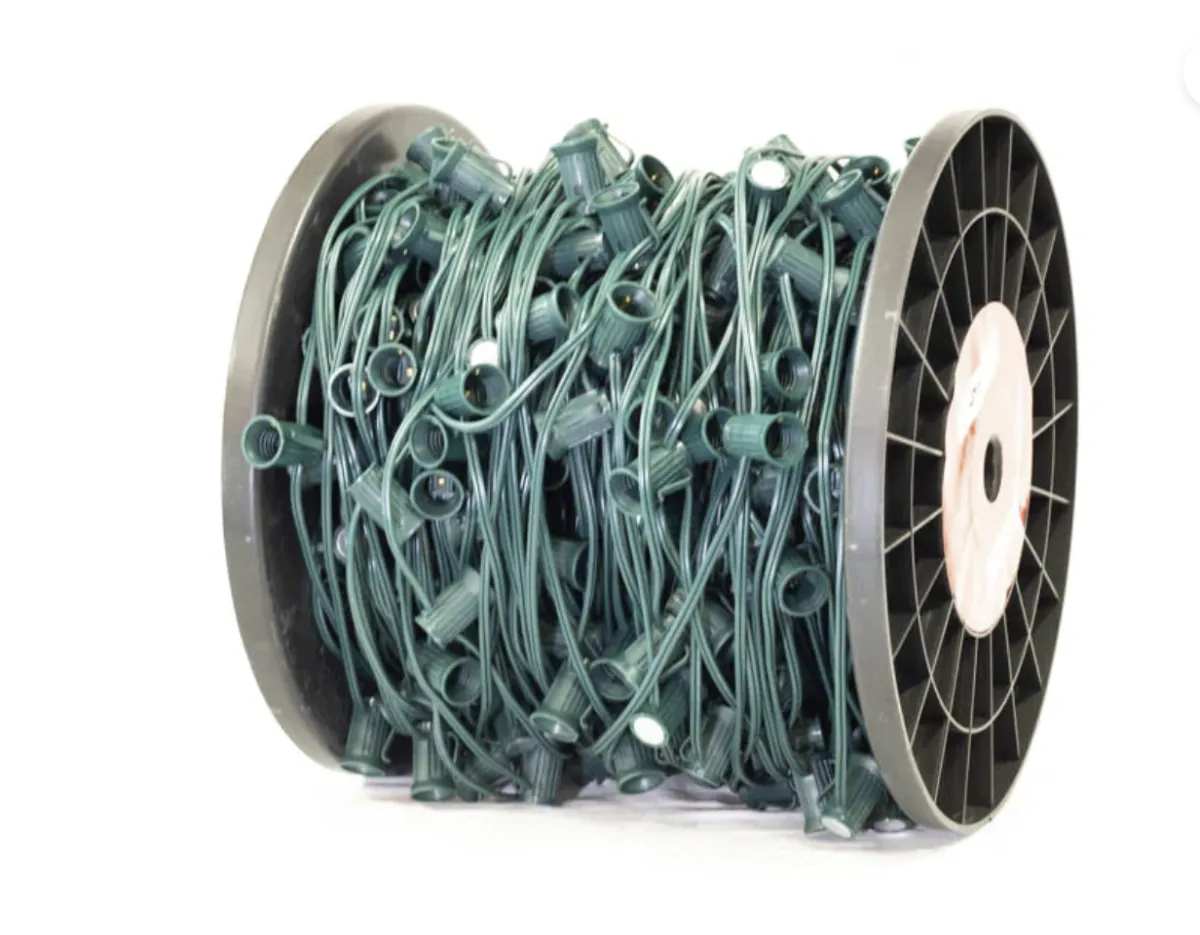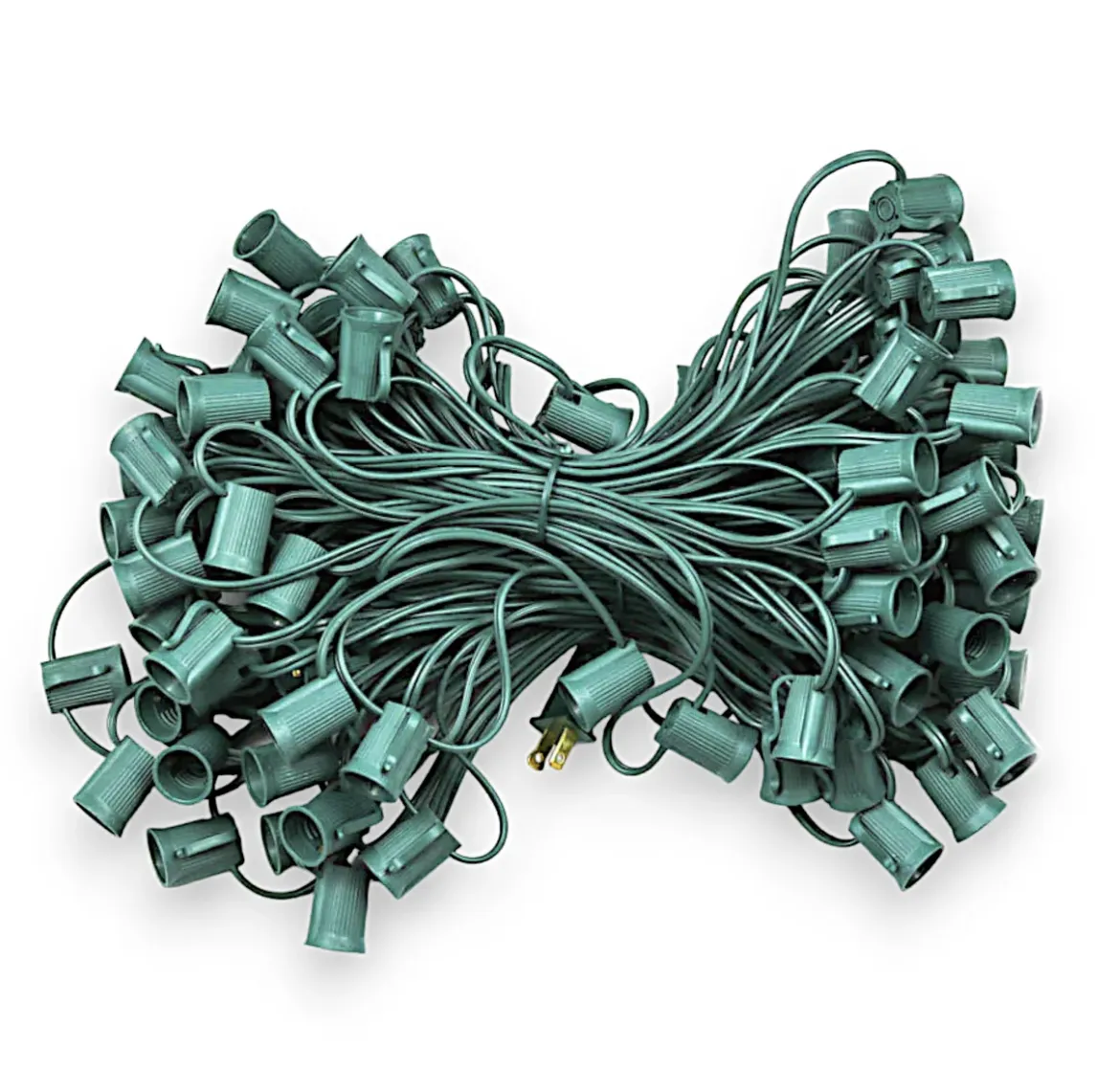C9 & C7 Socket Spools & Stringers
Discover our premium collection of socket wire spools and stringers, the essential foundation for creating stunning light displays. Designed for both professional installers and ambitious homeowners, our range includes bulk C7 and C9 socket wire spools with flexible spacing options, pre-made light stringers for quick setups, and convenient accessories like spool holders. These versatile, durable components are perfect for residential rooflines, enchanting tree displays, and large-scale commercial projects. Suitable for indoor and outdoor use, and compatible with both incandescent and LED bulbs, our professional-grade products offer the quality and flexibility needed to bring your creative lighting visions to life. Explore our selection and elevate your illumination projects with unmatched versatility and reliability.
Socket Spools
C9 1000' Socket Spool
Our C9 1000' Bulk Spool of Socket Wire, available in green or white, offers professional-grade flexibility for custom lighting projects. With spacing options from 6" to 48", it's ideal for both residential rooflines (12-15" spacing) and tree installations (24-48" spacing). The durable SPT-1 wire withstands outdoor conditions and is compatible with both incandescent and LED C9 bulbs. This customizable spool allows for precise length cutting, minimizing waste and maximizing efficiency for high-quality, adaptable lighting displays.
C9 500' Socket Spool
Our C9 500' Bulk Spool of Green Wire, available with 12" (500 sockets) or 15" (400 sockets) spacing, is perfect for professional-grade Christmas lighting installations. Featuring commercial-quality SPT-1, 8-amp wire and durable E17 sockets, this customizable spool is ideal for large-scale outdoor projects. Easily cut to desired lengths and pair with snap-on plugs (sold separately) for tailored lighting solutions in both residential and commercial settings. The 12" spacing offers vibrant, balanced lighting, while the 15" option provides a classic look with fewer bulbs per run.
C9 1000' 12"&15" Socket Wire Spool (SPT-2)
Our C9 1000' Socket Wire Spool (SPT-2) offers professional-grade flexibility with dual 12" and 15" spacing options. This customizable spool features heavy-duty SPT-2 wire for enhanced durability in all weather conditions. The 12" spacing is perfect for dense, vibrant displays on rooflines and pathways, while the 15" option provides a classic look with fewer bulbs per run. Compatible with both incandescent and LED C9 bulbs, this 1000' spool allows for precise cutting to fit any residential or commercial lighting project, ensuring efficient and long-lasting installations.
C7 1000' Green Wire Socket Spool (SPT-2)
Our 1000' bulk spool of green SPT-2 wire features 15" spacing with 1000 C7 sockets, ideal for commercial and residential outdoor displays. This 8-amp (960-watt) commercial-grade wire with Admiral Brand sockets allows for custom-length installations using snap-on plugs (sold separately). Suitable for indoor/outdoor use, it accommodates up to 160 sockets with 5-watt incandescent bulbs or 384 sockets with 1-watt LED bulbs per run. This versatile, durable C7 light line is perfect for creating professional-quality lighting displays in various settings.
C7 1000' Socket Spool
Our C7 1000' Bulk Spool of Socket Wire offers professional-grade flexibility for custom lighting projects. Available in green or white, with spacing options from 12" to 36", it's ideal for both residential rooflines (12-15" spacing) and tree installations (24-36" spacing). The durable SPT-1 wire withstands outdoor conditions and is compatible with both incandescent and LED C7 bulbs. This customizable spool allows for precise length cutting, minimizing waste and maximizing efficiency for high-quality, adaptable lighting displays in various settings.
C9/C7 500' Magnetic Spool
The Fastest Way to Install Holiday Lights on Metal Surfaces. Save time and effort this holiday season with Magnetic Spools. Designed for quick and easy installation, these magnetic spools are perfect for decorating your home or office building. The magnetic sockets eliminate the need for traditional mounting clips, making your installations faster and more efficient. Whether you’re lining rooflines, gutters, or fences, these spools are ideal for any surface where ferrous metal is present.
Available in 500' & 250', 12" or 15" Spacing.
Socket Wire Stringers
C9 12" Spacing Socket Wire Stringers
Our 25', 50' or 100' Holiday Light String features professional-grade, UV-protected 18-gauge wire with sockets spaced 12" apart. Designed for both indoor and outdoor use, these UL-recognized strings offer 5 Amp capacity SPT-1 insulation and durable sockets with weep holes for all-weather performance. Compatible with E12 Candelabra base bulbs (C7, C9, G30; sold separately), these versatile strings allow end-to-end connectivity for extended displays. Perfect for holiday decorations, event lighting, and year-round use in residential and commercial settings. Available in Green, White, Brown and Black.
C7 12" Spacing Socket Wire Stringers
Our professional-grade 25', 50' or 100' light string features sockets spaced 12" apart, perfect for commercial and residential decorators. Designed for both indoor and outdoor use, it's compatible with incandescent or LED C7, G30, and G40 bulbs (sold separately). The SPT-1 insulated wire offers 5 Amp capacity and includes weep-hole sockets for all-weather performance. With male and female plugs for end-to-end connections, these UL-recognized strings can handle up to 480 watts per run. Ideal for holiday displays, patio lighting, and year-round events, these durable strings ensure long-lasting, brilliant illumination for any occasion. Available in Green, White, Brown and Black.
Frequently Asked Questions
What's the difference between socket wire spools and stringers?
cket wire spools are bulk reels of wire with sockets at regular intervals, allowing for custom-length cuts. Stringers are pre-cut lengths of socket wire, typically with plugs attached, ready for immediate use.
Can I use the same socket wire for both C7 and C9 bulbs?
No, C7 and C9 bulbs require different socket sizes. Always check the product specifications to ensure you're using the correct socket wire for your chosen bulb type.
How do I determine the right spacing for my project?
Common spacings are 12", 15", and 24". Use closer spacing (12"-15") for dense, vibrant displays on rooflines or fences. Wider spacing (24" or more) works well for tree wrapping or creating a more subtle effect.
Are these socket wires suitable for outdoor use?
Most of our socket wires are rated for both indoor and outdoor use. Look for products labeled as "weatherproof" or "outdoor-rated" for the best durability in external conditions.
How many bulbs can I safely connect on a single run?
This depends on the wire's amperage rating and the wattage of your bulbs. For example, on an 8-amp wire, you can typically run up to 160 sockets with 5-watt incandescent bulbs or 384 sockets with 1-watt LED bulbs. Always check the product specifications and local electrical codes for safe operation.
Discover Expert Tips on Our Blog

Six Figure Service Business Growth Decoded
Running a successful service business requires more than just technical expertise—it demands strategic thinking, consistent action, and the right systems to scale effectively. Whether you're in the pressure washing, Christmas lights installation, or any other service industry, the fundamentals of business growth remain remarkably consistent across sectors.
This comprehensive guide covers the most critical aspects of building and scaling a service business, from navigating Google My Business challenges to implementing effective customer acquisition strategies that actually drive results.
Protecting Your Google My Business Profile: Critical Compliance Issues
The Growing Threat of Suspensions
Google My Business suspensions are becoming increasingly common, and many business owners are caught off guard when their profiles suddenly disappear. Understanding Google's requirements and staying compliant is essential for maintaining your online presence and avoiding costly disruptions to your lead generation.
Recent cases have highlighted several critical compliance issues that frequently trigger suspensions. One of the most common problems involves business name inconsistencies between your Google My Business profile and official state registrations. When your LLC is registered under one name but your Google profile uses a different name (even with a DBA), Google's algorithms may flag this as suspicious activity.
Business Address and Service Area Requirements
Google has become increasingly strict about service-based businesses using home addresses as their primary business location. If customers don't actually visit your location for services, Google requires you to set up your profile as a service-area business rather than listing a physical address where customers can visit.
Additionally, operating multiple Google My Business profiles from the same location can trigger automatic suspensions. This is particularly problematic for entrepreneurs running multiple service businesses from a single office or home-based location.
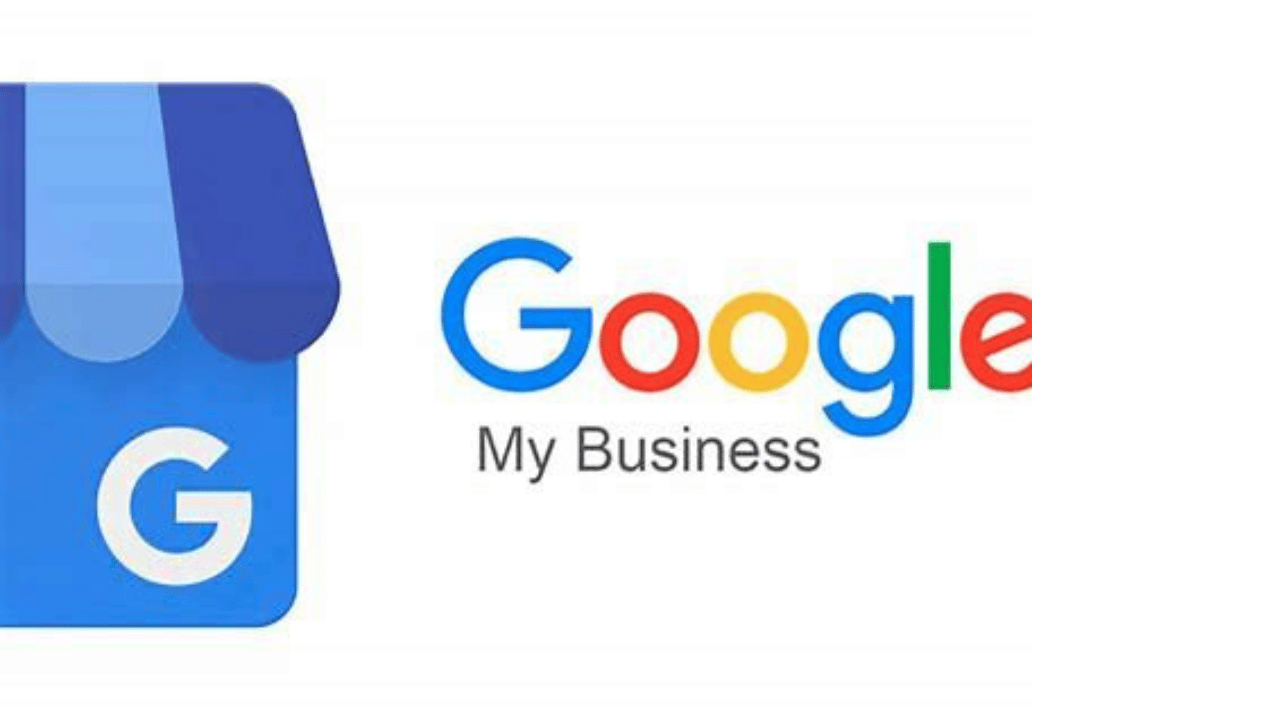
The LLC vs DBA Dilemma
While using a DBA (Doing Business As) might seem like a cost-effective way to operate multiple business lines, Google's verification systems are increasingly sophisticated at detecting discrepancies between your official business registration and your online presence. The safest approach is establishing separate LLCs for distinct service lines, even though this requires additional paperwork and potentially separate tax identification numbers.
This approach provides long-term protection for your business profiles and prevents the complications that arise when Google's algorithms detect inconsistencies in your business documentation.
Strategic Use of Virtual Assistants in Service Businesses
Understanding VA Capabilities and Limitations
Virtual assistants can provide tremendous value for service businesses, but success depends on understanding their optimal use cases and limitations. The most effective applications for VAs typically involve tasks that don't require direct customer interaction or deep local market knowledge.
Video editing represents one of the highest-value applications for virtual assistants, particularly for businesses investing in content marketing. VAs can handle time-consuming editing tasks while business owners focus on content creation and strategy development. Social media management is another area where VAs excel, provided they receive detailed guidelines about posting schedules, content types, and brand voice.
However, customer-facing activities should generally remain in-house or with local team members. VAs may lack the local knowledge, cultural understanding, and communication skills necessary for effective customer service, especially in service industries where trust and rapport are critical for closing sales.
Implementation Best Practices
Successful VA relationships require detailed systems and regular communication. Rather than providing vague instructions like "post five times daily," effective delegation involves creating step-by-step processes that specify exact posting times, content sources, formatting requirements, and approval workflows.
Regular check-ins are essential for maintaining quality and alignment. Scheduling brief conversations three to five times per week ensures VAs stay on track and allows for quick course corrections before small issues become significant problems.
The rise of AI tools is changing the VA landscape significantly. Many tasks traditionally handled by virtual assistants—from content creation to basic video editing—can now be accomplished more efficiently using AI platforms. Smart business owners are evaluating which tasks truly require human creativity and judgment versus those that can be automated entirely.

Mastering Cold Calling: Frameworks That Generate Results
Building Targeted Prospect Lists
Effective cold calling begins with identifying the right prospects and obtaining accurate contact information. For service businesses targeting commercial clients, industry associations provide excellent starting points for building prospect databases.
Apartment associations, property management companies, and commercial real estate organizations often publish member directories that include contact information for decision-makers. While membership fees (typically $500-$1000 annually) might seem expensive, access to these databases can generate substantial returns when used strategically.
LinkedIn serves as another powerful prospecting tool, particularly for identifying property management companies that oversee multiple locations. Rather than cold calling individual properties, targeting management companies allows you to reach decision-makers who control multiple potential job sites.
Relationship-Building vs. Direct Sales Approaches
The most successful cold calling strategies focus on relationship building rather than immediate sales pitches. Instead of opening with service offerings, effective callers lead with genuine compliments, relevant observations, or industry insights that demonstrate expertise and build rapport.
The goal is getting past gatekeepers and establishing credibility with decision-makers. This requires understanding the prospect's challenges, demonstrating industry knowledge, and positioning yourself as a valuable resource rather than just another vendor seeking work.
Building trust through initial conversations creates opportunities for future business, even when immediate needs don't exist. Many successful service businesses generate their highest-value contracts from relationships developed through patient, value-focused outreach efforts.
The Three Pillars of Customer Acquisition
Yard Signs: The Underestimated Powerhouse
Despite their unglamorous appearance, yard signs consistently deliver some of the highest returns on investment for local service businesses. Businesses generating millions in annual revenue continue using yard signs because the mathematics are compelling—often producing 10x to 20x returns compared to other marketing channels.
The key to yard sign success lies in consistent deployment and strategic placement. Rather than putting out signs sporadically, successful businesses treat yard sign placement as a systematic weekly activity. Some operators deploy 100+ signs weekly, treating each sign as a specific ROI-generating asset.
Effective yard signs follow simple design principles: clear service identification, large phone numbers, and minimal text. The goal isn't creating artistic masterpieces—it's generating phone calls from qualified prospects who need your services.

Digital Foundation: Website and Social Media Integration
While yard signs drive immediate response, your digital presence provides the credibility and information prospects need to convert into customers. This includes an optimized website, active social media profiles, and a robust Google My Business presence that work together to build trust and demonstrate expertise.
Your website serves as the central hub where prospects verify your legitimacy and evaluate your capabilities. High-quality photos of completed projects, clear service descriptions, and prominent contact information help convert interest into inquiries.
Social media platforms extend your reach and provide ongoing touchpoints with potential customers. Regular posting keeps your business visible in local feeds while demonstrating activity and expertise to prospects researching your services.
Paid Advertising: Strategic Investment for Scalability
Paid advertising represents the third pillar of customer acquisition, providing scalable lead generation when implemented correctly. For Christmas lights businesses, Facebook advertising often produces excellent results due to the visual nature of the service and seasonal purchasing patterns.
Pressure washing and other year-round services typically see better returns from Google Ads, where prospects are actively searching for solutions to immediate problems. The key is matching your advertising platform to customer behavior patterns and search intent.
Effective paid advertising requires ongoing optimization and budget management. Start with modest investments to test messaging and targeting before scaling successful campaigns to higher spending levels.
Surviving and Thriving During Slow Seasons
Commercial Contract Development
The most effective strategy for maintaining revenue during slow residential periods involves developing commercial relationships during busy seasons that can provide steady work during slower months. This requires thinking ahead and building relationships before you need the work.
Commercial contracts often involve longer sales cycles but provide more predictable revenue streams and higher-value projects. Property management companies, apartment complexes, and commercial facilities require ongoing maintenance that can keep crews busy when residential demand drops.
Joining relevant trade organizations and attending industry events provides access to commercial decision-makers and keeps your business visible when budgeting decisions are made. The investment in membership fees and networking time typically pays substantial returns through contract opportunities.

Service Diversification Strategies
Adding complementary services can help smooth seasonal revenue fluctuations while leveraging existing customer relationships and equipment investments. However, diversification requires careful consideration of profitability, skill requirements, and market demand.
Some service businesses successfully add deck cleaning and staining during slower periods, though this requires developing specialized expertise and managing different equipment needs. The key is choosing additions that complement core services without creating operational complexity that reduces overall profitability.
Building customer databases and maintaining regular communication allows you to promote seasonal services to existing clients who already trust your work quality. Text messaging and email campaigns can generate immediate responses when offering limited-time services or availability.
The Psychology of Business Success: Mindset and Action
Overcoming Limiting Beliefs About Pricing
Many service business owners significantly undervalue their services due to limiting beliefs about what customers will pay or what their market can support. These mental barriers often prevent businesses from achieving their full potential and create unnecessary struggle in building profitable operations.
Successful businesses regularly test higher pricing levels and are often surprised by customer acceptance of premium rates. The key is understanding that price resistance frequently reflects poor positioning or value communication rather than actual market limitations.
Premium pricing requires confidence and the ability to articulate value clearly. When you can demonstrate superior results, reliability, or service quality, customers often prefer paying more for certainty rather than gambling on lower-priced alternatives.
The Action Imperative
The gap between business knowledge and business results is implementation. Many entrepreneurs spend excessive time researching strategies, reading about success, and planning perfect approaches while neglecting the basic actions that drive actual results.
Successful businesses prioritize consistent daily actions over perfect strategies. Whether it's placing yard signs, making follow-up calls, or posting social media content, regular implementation of basic activities typically produces better results than sporadic execution of sophisticated strategies.
The fear of rejection, failure, or embarrassment prevents many business owners from taking necessary actions. However, these fears often prove unfounded, and the regret of inaction typically exceeds the temporary discomfort of taking imperfect action.

Systems and Scalability: Building Beyond Yourself
Creating Replicable Processes
Business growth requires developing systems that function independently of the owner's direct involvement. This means documenting processes, training team members effectively, and creating accountability mechanisms that maintain quality standards without micromanagement.
Many service business owners become trapped in daily operations because they haven't invested time in creating systems that others can follow. This limits growth potential and creates businesses that depend entirely on the owner's presence and decision-making.
Effective systems cover everything from customer acquisition and service delivery to quality control and financial management. While creating these systems requires initial time investment, they provide the foundation for sustainable scaling and eventually allow owners to focus on strategic rather than operational activities.
Investment in Continuous Learning
The most successful business owners treat education and skill development as ongoing investments rather than one-time expenses. This includes reading relevant books, attending industry conferences, and working with mentors or coaches who have achieved similar success.
The networking opportunities at quality industry events often prove more valuable than the formal educational content. Relationships built with other successful business owners provide ongoing learning opportunities, potential partnerships, and motivation during challenging periods.
Investing in personal development typically produces higher returns than investing in equipment or marketing because improved skills and knowledge compound over time and apply to every aspect of business operations.
Moving Forward: The Path to Sustainable Growth
Success in service businesses isn't about finding secret strategies or perfect timing—it's about consistent execution of proven fundamentals combined with the flexibility to adapt as market conditions change. The businesses that thrive long-term focus on building strong foundations rather than chasing the latest trends or shortcuts.
Whether you're just starting your service business or looking to scale beyond current limitations, the principles outlined in this guide provide a roadmap for sustainable growth. The key is choosing which strategies align best with your current situation and implementing them consistently rather than trying to do everything simultaneously.
Remember that business growth requires both strategic thinking and tactical execution. While planning and preparation are important, nothing replaces the results that come from taking consistent action toward your goals. The phone won't ring simply because you have good intentions—it rings because you've implemented systems and strategies that make it ring.
The most successful service business owners understand that growth is a process, not an event. They focus on daily activities that compound over time rather than looking for dramatic breakthroughs or overnight success. This approach builds businesses that can weather economic changes, competitive pressures, and seasonal fluctuations while continuing to grow and profit year after year.

Q1: My Google My Business profile was suspended and I didn't do anything wrong. What are the most common causes and how can I avoid this?
A: Google My Business suspensions are increasingly common due to stricter compliance enforcement. The most frequent causes include business name inconsistencies between your Google profile and state registration (even with a valid DBA), using home addresses for service-based businesses instead of setting up service-area profiles, and operating multiple Google profiles from the same location. To avoid suspension, ensure your business name exactly matches your state registration, configure service-based businesses properly without physical addresses, and establish separate LLCs for different service lines rather than relying on DBAs. The safest approach is having separate legal entities for distinct businesses, even though it requires additional paperwork.
Q2: When should I hire a virtual assistant and what tasks should I avoid giving them?
A: Virtual assistants work best for tasks that don't require direct customer interaction or local market knowledge. Ideal VA applications include video editing, social media content creation (with detailed guidelines), follow-up email sequences, and administrative tasks. However, avoid using VAs for customer-facing activities like phone sales, customer service, or local market outreach since they may lack cultural understanding and local knowledge crucial for building trust. When hiring VAs, provide step-by-step processes rather than vague instructions, and schedule regular check-ins 3-5 times weekly. Remember that AI tools are now handling many tasks traditionally given to VAs, so evaluate whether automation might be more efficient than human assistance.
Q3: What's the most effective framework for cold calling commercial prospects?
A: Start by building targeted prospect lists through industry associations (like apartment associations) or LinkedIn to identify property management companies that oversee multiple locations. Focus on relationship-building rather than direct sales pitches—open with genuine compliments, relevant observations, or industry insights rather than immediate service offers. The goal is getting past gatekeepers and establishing credibility with decision-makers. Target management companies instead of individual properties since they control multiple potential job sites. Success comes from positioning yourself as a valuable resource and demonstrating industry expertise, which creates opportunities for future business even when immediate needs don't exist.
Q4: Are yard signs really worth the effort, and why do million-dollar businesses still use them?
A: Yes, yard signs consistently deliver 10x to 20x returns on investment, which is why businesses generating millions in annual revenue continue using them systematically. The key is treating yard sign placement as a weekly systematic activity rather than sporadic deployment. Successful operators place 100+ signs weekly, treating each as a specific ROI-generating asset. Effective design follows simple principles: clear service identification, large phone numbers, and minimal text. While they may look "trashy" compared to digital marketing, yard signs generate immediate phone calls from qualified local prospects who need your services right now, making them one of the highest-converting marketing channels available.
Q5: What are the three most effective customer acquisition strategies for service businesses?
A: The three pillars are yard signs (highest ROI for immediate response), digital foundation (website, social media, Google My Business working together for credibility), and strategic paid advertising (Facebook ads for visual services like Christmas lights, Google Ads for problem-solving services like pressure washing). Yard signs drive immediate calls, your digital presence provides the credibility prospects need to convert, and paid advertising offers scalable lead generation when implemented correctly. The key is implementing all three systematically rather than jumping between strategies, since they work synergistically to build trust and generate consistent leads.

Q6: How do I survive slow seasons without losing my team or going broke?
A: Develop commercial relationships during busy seasons that provide steady work during slower periods. Commercial contracts have longer sales cycles but offer more predictable revenue and higher-value projects. Join trade organizations, attend industry events, and target property management companies that need ongoing maintenance. Build customer databases for text and email campaigns promoting seasonal services to existing clients who already trust your work. Consider complementary services like deck cleaning during slow periods, but choose additions that leverage existing skills and equipment without creating operational complexity that reduces profitability.
Q7: I'm afraid to raise my prices because I think customers won't pay. How do I overcome this mindset?
A: Price resistance often reflects poor positioning or value communication rather than actual market limitations. Many service business owners significantly undervalue their services due to limiting beliefs about what their market can support. Test higher pricing levels systematically—you'll often be surprised by customer acceptance of premium rates. Premium pricing requires confidence and clear value articulation. When you can demonstrate superior results, reliability, or service quality, customers often prefer paying more for certainty rather than gambling on lower-priced alternatives. Remember: if you don't ask for higher prices, you'll never receive them.
Q8: Should I focus on residential or commercial work, and what are the key differences?
A: Both have advantages, but commercial work provides more stability during slow seasons. Residential work offers quicker sales cycles and immediate cash flow, while commercial contracts involve longer sales cycles but provide predictable revenue streams and higher-value projects. The ideal approach is running residential work for immediate cash flow while building commercial relationships for seasonal stability. Commercial requires different skills—relationship building, professional presentations, and understanding of longer approval processes. Many successful businesses run mixed models: more residential during peak seasons and shift to commercial during slower periods to maintain steady revenue.
Q9: I spend a lot of time planning and researching strategies but don't see results. What am I missing?
A: The gap between business knowledge and results is implementation. Many entrepreneurs spend excessive time researching perfect strategies while neglecting basic actions that drive actual results. Success comes from consistent daily execution of proven fundamentals rather than sporadic implementation of sophisticated strategies. Focus on activities that directly generate revenue: placing yard signs, making follow-up calls, posting social media content, and contacting prospects. The fear of rejection or failure prevents necessary actions, but these fears are usually unfounded, and regret from inaction typically exceeds temporary discomfort from imperfect action. Choose 2-3 strategies and execute them consistently rather than trying everything simultaneously.
Q10: How do I build systems that allow my business to operate without me constantly being involved?
A: Document all processes, from customer acquisition and service delivery to quality control and financial management. Create step-by-step procedures that others can follow without your direct involvement. Train team members effectively and establish accountability mechanisms that maintain quality standards without micromanagement. Many service business owners become trapped in daily operations because they haven't invested time in creating systems others can follow. Start by documenting your most critical processes, then gradually train others to handle routine decisions and operations. This requires initial time investment but provides the foundation for sustainable scaling and eventually allows you to focus on strategic growth rather than daily operations.
Copyright ©2025 All Right Reserved website designed by christmaslights.io
Terms of Service / Privacy Policy
Have questions or need assistance?
Contact us at (855)619-LITE


